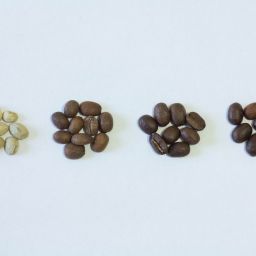
The Aeropress has emerged as a beloved tool among coffee enthusiasts for its versatility and the exceptional quality of brew it can produce. This innovative brewing method utilizes air pressure to push hot water through coffee grounds, resulting in a cup that combines the best aspects of espresso and drip coffee.
The choice of coffee beans plays a pivotal role in the Aeropress’s ability to deliver a rich and nuanced cup. Selecting the right beans can enhance the brewing process, tailoring the flavor, acidity, and body of the coffee to the drinker’s preference. Understanding the characteristics that contribute to a bean’s suitability for Aeropress is essential for achieving the perfect brew.
Factors to Consider When Choosing Coffee Beans for Aeropress
Roast Level
The roast level of coffee beans significantly impacts the flavor profile of the brew. Light roasts are known for their bright acidity and complex flavor notes, ranging from floral to fruity. They are ideal for those who appreciate the subtle nuances of coffee.
Medium roasts offer a balanced flavor, with a reduction in acidity and the emergence of more body and sweetness, making them versatile for Aeropress brewing. Dark roasts are characterized by their bold, rich flavors and lower acidity, often with hints of chocolate or caramel, suitable for those who prefer a strong, full-bodied cup.
The choice of roast level influences the extraction and final taste, making it a crucial consideration for Aeropress users.
Bean Origin
The origin of coffee beans affects their taste profile due to variations in soil, climate, and cultivation methods. Beans from Africa, such as Ethiopian Yirgacheffe, are celebrated for their floral and fruity notes, adding a unique dimension to Aeropress coffee.
Latin American beans, like those from Guatemala Antigua, offer a sweet and balanced cup with hints of nuts and chocolate. Asian beans, such as Sumatra Mandheling, provide a full-bodied experience with earthy and spicy flavors. Each origin brings its distinct characteristics, allowing Aeropress brewers to explore a world of flavors.
Whole Beans vs. Pre-Ground
Choosing between whole beans and pre-ground coffee can affect the freshness and flavor of the Aeropress brew. Whole beans, when ground just before brewing, ensure the highest level of freshness, preserving the coffee’s oils and flavors.
This option allows for adjusting the grind size to match the Aeropress’s optimal extraction, a crucial factor for achieving the desired taste profile. Pre-ground coffee offers convenience but may compromise on freshness and flavor integrity, as coffee begins to lose its aromatic compounds shortly after grinding.
For Aeropress enthusiasts looking to maximize the quality of their brew, whole beans are the recommended choice.
Onyx Coffee Lab Whole Bean Ethiopian
Onyx Coffee Lab is renowned for its Ethiopian Gedeb Beriti Natural, a coffee that boasts a complex flavor profile, including notes of dried berries, cantaloupe, and sorghum. This coffee exemplifies the modern approach to coffee roasting, straddling the line between traditional and contemporary flavors.
The roaster’s commitment to quality is evident in their practice of roasting beans only upon order, ensuring maximum freshness. However, the uniqueness of this coffee comes with the limitation of its availability—since it’s roasted to order, you might have to wait a bit longer to enjoy it.
Lifeboost Optimist Light Roast Organic Coffee
Lifeboost’s Optimist Light Roast Organic Coffee shines with its bright and lively stonefruit notes, offering a crisp and consistent flavor profile. As a single-origin, 100% Arabica coffee, it stands out for its quality and taste. Certified by Fair Trade, Rainforest Alliance, and USDA Organic, this coffee not only promises a delightful cup but also adherence to ethical and environmental standards.
The light roast enhances its brightness and acidity, perfect for those who prefer a lighter, more nuanced cup. However, its lightness may not cater to all palates, especially those accustomed to bolder flavors.
Stumptown Coffee Roasters Guatemalan Whole Beans
Stumptown Coffee Roasters brings forth a Guatemalan coffee with captivating notes of orange, honey, and butter. This particular bean is recommended for Aeropress due to its light and acidic profile, which is enhanced by the brewing method.
Stumptown suggests adjusting the brewing time to highlight different flavor notes, offering a versatile brewing experience. Despite its high quality, some users have reported inconsistency with freshness, a critical factor in the coffee’s overall taste.
Blends Perfect for Travelers
For those constantly on the move, certain blends are designed with the traveler in mind. These coffees offer a balance of flavor and convenience, ensuring a quality cup regardless of location. Medium espresso roasts, combining Arabica and Robusta beans, provide a harmonious experience with hints of roasted hazelnut and brown sugar.
These blends are characterized by their creamy flavor and non-oily texture, making them a versatile choice for Aeropress brewing. However, some might find these blends too mild, lacking the intensity desired in a coffee.
Klatch Coffee Belle Espresso
The Belle Espresso from Klatch Coffee is an espresso blend that delivers an AeroPress-made espresso-like cup with clear notes of blackberry, chocolate, and brandy. This blend is celebrated for its ability to combine a creamy body with the complex flavors expected from a top-tier espresso.
The Belle Espresso’s acclaim is partly due to its high rating by coffee critics, marking it as a standout choice for Aeropress users seeking depth and complexity. The drawback, however, is its labeling, which has confused some customers regarding whether it’s whole bean or pre-ground.
Brewing Tips for Perfect Aeropress Coffee
Achieving the perfect Aeropress coffee involves precise control over grind size, water temperature, and brewing time. Grind size should be medium-fine, akin to table salt’s texture, to ensure optimal extraction without overpassing or clogging the filter.
Water temperature is best set between 195°F to 205°F (90°C to 96°C), balancing extraction efficiency without scalding the coffee. Brewing time should range from 1 to 2 minutes; starting with a 30-second bloom where hot water allows the coffee to pre-infuse and release gases, followed by a steady plunge that extracts the coffee without bitterness.
FAQs
What is the ideal grind size for Aeropress? Medium-fine grind is recommended for Aeropress to balance extraction rate and avoid clogging.
How should I store my coffee beans? Store beans in an airtight container at room temperature, away from direct sunlight and moisture, to maintain freshness.
Can I adjust the Aeropress method for different coffee beans? Yes, adjust grind size, water temperature, and brewing time based on the roast level and origin of the beans to enhance flavor profiles.
Conclusion
Selecting the best coffee beans for Aeropress and mastering the brewing process requires understanding the nuances of roast levels, bean origins, and the impacts of grind size, water temperature, and brewing time.
Experimentation is key; by adjusting these variables, you can unlock the full potential of coffee beans and discover your ideal Aeropress cup. Embrace the journey of exploration, and let each brew be an opportunity to refine your coffee experience.








